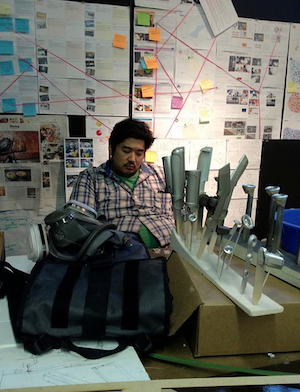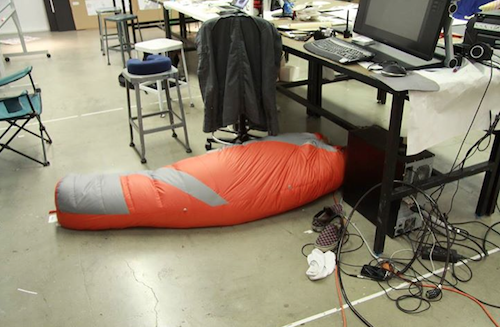In addition to the beautiful illustrations and sleek looking car models adorning the halls at Art Centers’ Hillside Campus, there’s an intriguing installation viewable to students and visitors alike. In the library, on couches in the hallway and on top of most any flat surface available: students can be found splayed out catching some shut-eye, desperate for a place to rest their head during the long demanding days and weeks of the term.
Rumors and horror stories flood new students, with tales of students who crashed their cars and somehow walked away unharmed (i.e.’How funny it is that so-and-so hurt themselves while building a model?’) and how people in authority positions support and contribute to this propaganda of self-denial. As the student population diversifies in age and life experience it is clear that additional co-curricular and non-curricular structures are necessary to continue producing top-notch designers and artists.
To address this problem, the CSE opened Nap Room (located in A1 of the Annex) on July first to serve the needs of students working around the clock to complete projects in the final weeks of the Summer term. But this is only a temporary solution. The College really needs a year-round space for students to rest and recharge. It’s also worth noting that the nap room will not have a dedicated space during the Fall due to the large incoming class, additional space needed for graduate programs and additional conference rooms. Several members of Student Government are looking at innovative solutions to create a place of renewal, including occupying the halls with couches and then creating a “nap map.”
With an ever-increasing international population and many first time freshmen, many students lack the grounding and outside community support that previously sustained older students outside the classroom. A bulk of today’s students come in without life experience, a solidified moral compass or knowledge that when a professor tells them not to yawn in a classroom that it’s theater, institutional farce.
This need has not gone unnoticed by the students. Along with sleeping in conspicuous places, some have organized a closed group on Facebook, aptly named Nap Time, to highlight the issue and post pictures of people sleeping across campus. The humor and public embarrassment-laden action thinly veils the critical lack of support for students who spend days at a time on campus, some seemingly living out of their cars or in unused classrooms.
Bryce Shawcross, former Student Government President, saw the need for a rest space a few years ago after seeing the high number of reports of students crashing their cars on and off campus after falling asleep at the wheel. There’s also the problem of the reputed practice of working and going to class sleepy, leading to minor injuries and a less than ideal classroom environment. Together with the Board of Trustees, Operations and the Facilities team, he set up a nap room in an empty classroom space and eventually a nap tent outside the cafeteria. Incidents of on-campus and vehicular accidents among students have drastically declined since the installation of the nap room. Still, its relevancy comes into question every term and requires constant vigilance in order to maintain this service on campus.
“The nap room and sleep are integral to the creative experience,” Jom Rivers, Student Government Director of events notes. “People are already sleeping on campus, the quality of rest they’re getting on those couches is horrible. The nap room encourages quality rest, and begins to reduce the stigma surrounding downtime in the black rectangle.”
Bryce confirms, “If Art Center is to request so much of its students, it must be prepared to support all of the physical, emotional and spiritual needs through resources like the nap room, in addition to other wellness and awareness resources campaigns.”
See also: Harvard Nap Room
Tyler Bennett is the Student Government President of Art Center College of Design











